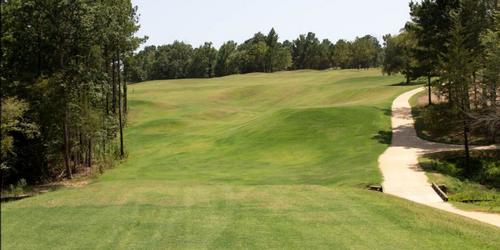
Golf excellence times two at sublime TPC San Antonio
Courses designed by Norman and Dye make for bucket-list trip to the Alamo City
By Steve Habel
The PGA Tour loves San Antonio and having the Alamo City - and its huge charitable contributions - as a tour stop each year. The Valero Texas Open (or one of its other names) has been a San Antonio staple since 1922 and is the Tour's third-oldest event.
The tournament is now played at the AT&T Oaks Course at the fabulous TPC San Antonio and JW Marriott San Antonio Hill Country Resort & Spa in northeast San Antonio. The AT&T Oaks Course is one of two tracks, along with the AT&T Canyons Course, at the sprawling resort.
Located just 20 minutes from the San Antonio International Airport, the JW Marriott San Antonio Hill Country Resort & Spa offers the beauty of the Texas Hill Country combined with nearby city and luxury-resort conveniences.
TPC San Antonio was built to be a model of environmentally sound methods and practices, beginning with the AT&T Canyons Course, one of the best-planned eco-friendly layouts ever conceived. A closed-loop irrigation system ensures the protection of the Edwards Aquifer, the main water supply for the City of San Antonio and points south and west. Construction called for more than 60,000 tractor-trailer loads of sand, clay and soil to shape the two courses.
The abundant natural resources neighboring the two courses and resort comprise 900 acres of open space (including a sanctuary that protects the golden-cheeked warbler) and meandering creeks.
Tour-difficulty golf is at the heart of AT&T Oaks
The AT&T Oaks Course is tough, and that was part of the plan. Designed by Greg Norman with assistance from Sergio Garcia, the course was blasted out of the rock that defines the site then built up with mounding, gnarly bunkering, water features and demanding greens complexes. The result is a layout that looks like it's always been on the spot as it blends seamlessly with the surrounding topography and native vegetation.
Norman's design philosophy is underscored by environmental sensitivity. Great care was taken to incorporate the distinct nuances and indigenous flora of the site into the course to create a compelling, strategically diverse and strikingly beautiful venue for golfers.
"The subtleties of the rolling Texas Hill Country terrain and the magnificent stands of mature live oaks helped me create a pristine natural setting that is as playable as it is beautiful," Norman said.
The AT&T Oaks Course has been criticized, correctly in my opinion, for being too tough for the average golfer, but that was not the focus prior to construction: it was designed for the PGA Tour player, specifically those in the Valero Texas Open.
The par-72 course plays at 7,435 yards from its back (Tiburon) tees, where it merits a rating of 76.5 and a 148 slope. Noteworthy is its healthy set of par-4s, including five of at least 447 yards. Three of the par-3s stretch at least 207 yards, and two of the four par-5s are longer than 600 yards.
But there is so much more to discuss about the AT&T Oaks Course than mere length. Start with the sometimes-sheer-faced limestone walls that frame some holes, and continue by talking about the need to hit long, high, precise iron shots into just about every green. Those targets are almost always perched above the fairway, with one of them a shared green (for holes 2 and 7), and another with a bunker in the middle - a la the one 1,200 miles away at Riviera Country Club.
Canyons is an excellent second option at TPC San Antonio
Due to the differing topography, the Pete Dye-designed AT&T Canyons Course, paired with Norman's AT&T Oaks Course, complement one another with each having a unique look, feel and playing experience for members and resort guests.
While very different from its tougher, tree-lined onsite sister, the Canyons Course stands on its own as a tournament venue in terms of design, strategy and beauty. The track played host to PGA Tour Champions' San Antonio Championship from 2011-2015.
Dye (and design consultant Bruce Lietzke) were given a great piece of ground for the Canyons Course that dictates the strategy and design, the latter of which is true to the flow of the land. Carded at a par of 72 and at 7,106 yards from the back tees, the course's corridors provide panoramic views.
Wider and hillier than its AT&T Oaks sibling, many of its holes overlook a 750-acre nature preserve. Some who have played the Canyons Course say it doesn't look like a Dye design, but upon closer inspection, golfers will find plenty of the Scottish pot bunkers the architect is known for as well as a few other wrinkles, including some church pew-style bunkers on the par-4 ninth.
Bermuda grasses were specially selected for this course to provide optimum playing conditions, diversity in color and texture and environmental sensitivity.
The Canyons Course actually runs along the ridges, with strategy dictated by Dye's trench bunkers. It's fun and playable, even in a two-club wind, and a challenge for scratch golfers and novices alike with dramatic elevation changes.
There are a few straightforward holes early in the round, but things get interesting on the last four holes.
While many resorts have 36 holes, often the focus and energy is put into one 18 holes, while the other is neglected or clearly a second-tier option. You cannot say that about the Canyons at the TPC San Antonio. From a visual standpoint, the Canyons is a much more scenic course, with conditions almost the same as the Oaks, just not quite as fast and firm.
The TPC San Antonio has exceptional practice facilities: a 20-acre complex with six tee decks and numerous target greens. A short-game area has two large stations that replicate course conditions on and around the greens and in the bunkers. And for those needing further help, the facility's PGA Tour Academy of Golf is as good as found anywhere.
Revised: 01/15/2020 - Article Viewed 25,422 Times
- View Course Profile
About: Steve Habel
![]() Steve Habel is a contributing editor for GolfTrips and its associated websites. A 26-year industry veteran, he regularly contributes to various regional, national and international golf publications and has played and written about more than 1,600 golf courses around the world.
Steve Habel is a contributing editor for GolfTrips and its associated websites. A 26-year industry veteran, he regularly contributes to various regional, national and international golf publications and has played and written about more than 1,600 golf courses around the world.
Habel is also senior editor for Horns Illustrated magazine, a publication focusing on University of Texas sports, as well the San Antonio Spurs beat writer for The Sports Xchange. He is a correspondent for the Austin American-Statesman and frequently files stories and features for The Associated Press and Preferred Lifestyle magazine.
Habel, who lives in the Austin, Texas area, has worked media coordinator for World Golf Hall of Fame player and golf architect Tom Kite as well as for renowned golf architects Roy Bechtol and Jeffrey D. Brauer.
He is a member of the Golf Writers Association of America, the Texas Golf Writers Association and the Football Writers Association of America.















